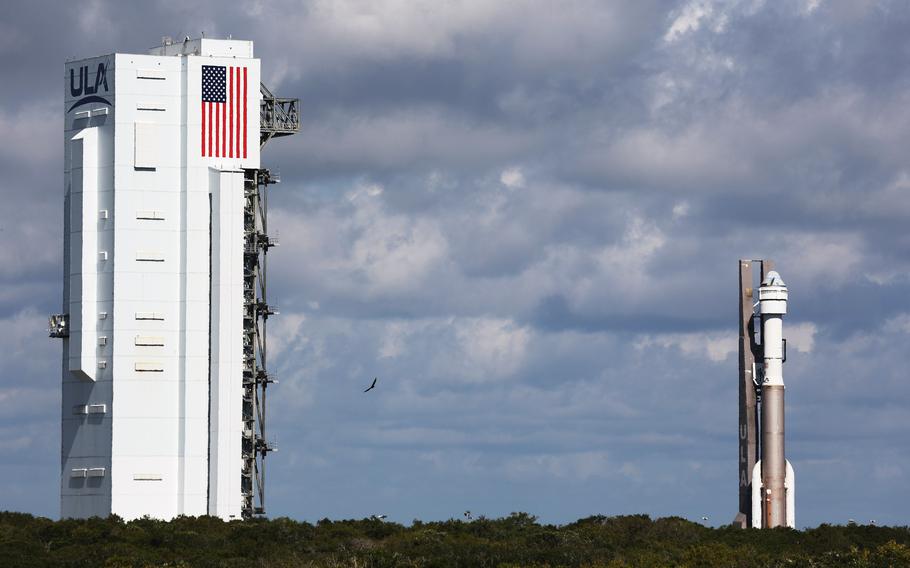
Starliner rolls out of the Vertical Integration Facility at the Cape Canaveral Space Force Station Space Launch Complex 41, on Saturday, May 4, 2024. (Ricardo Ramirez Buxeda/Orlando Sentinel/TNS)
(Tribune News Service) — NASA wants more time to look at data related to problems with Boeing’s Starliner thrusters and helium leaks before letting a pair of NASA astronauts make their way back to Earth, again pushing back a planned return date from the International Space Station.
The new target departure of Butch Wilmore and Suni Williams is no earlier than Tuesday, June 25, extending again what was supposed to be about an eight-day visit to the ISS in the the first human spaceflight for the commercial Starliner capsule and service module.
The astronauts launched from Cape Canaveral Space Force Station atop a United Launch Alliance Atlas V rocket on June 5, but on the way to docking at the ISS on June 6, the capsule experienced a series of helium leaks and thruster failures on its propulsion service module.
“Teams have been very busy reviewing the data and executing the on-orbit flight test objectives for the mission,” said NASA Commercial Crew Program manager Steve Stich during a press conference Tuesday.
The plan would be to depart the ISS on June 25 at 10:10 p.m. and make the 6 1/2-hour trip home with a landing at 4:51 a.m. Wednesday, June 26, at the primary site of White Sands Space Harbor, New Mexico. A backup landing date would target July 2.
The completion of Starliner mission would set up what NASA and Boeing hope is full certification of the spacecraft so it can begin sharing duties with SpaceX of ferrying astronauts to and from the ISS on regular six-month missions.
But before it heads home, NASA and Boeing are taking time to look at all the issues with the service module, which has stretched the astronauts’ stay to at least 19 days before undocking.
“The service module is a component that we don’t get back,” Stich said. “After we execute the deorbit burn, it burns up in the atmosphere and so we’re taking our time to understand that service module and the things that we’ve had happen relative to the helium leaks and also the thruster fail offs at docking.”
In the meantime, NASA has kept Wilmore and Williams busy checking out habitability of the Starliner capsule and helping out with science and research experiments on the orbiting laboratory.
“ISS is happy to have Butch and Suni to be on board the space station,” Stich said. “We’re putting them to work and getting a lot of work out of them.”
Boeing has six missions contracted to fly with Starliner, with one potentially flying as early as next February, but that could also be delayed until the fall.
Already Boeing is about four years behind SpaceX, which has been handling U.S.-based astronaut launches since the first Crew Dragon human spaceflight in May 2020. SpaceX’s fleet of Crew Dragons have since flown 13 times carrying 50 humans to space.
Boeing’s commercial crew program lead Mark Nappi welcomes the extra time on station.
“We look at that as an opportunity and in this case, a privilege to stay on station and do more work,” he said. “We’ve always said this is a test flight. We’re going to learn some things. So here we are.”
He says that while the helium leaks have remained manageable, “it’s still not working like we had designed it. So we got to go figure that out” as well as figuring out why some of the thrusters shut down during the docking phase.
“So what is it at this point we can learn based on the fact that we’re on station and we’re safe,” Nappi said. “Is there testing we can do or more data analysis that needs to be done so we can take advantage of where we are?”
Those questions led to a test this past weekend on the service module that showed the helium leaks are more stable and thruster performance more normal than what it experienced on the flight up, Nappi said, but poring over the data from the test is the primary reason to spend more time on station.
Results led NASA to already clear the spacecraft for use immediately in case of an emergency, but now teams will perform further review ahead of the normal departure.
“That’s good information to have at this point,” he said. “That leads us to believe that we have a good, safe spacecraft.”
©2024 Orlando Sentinel.
Visit orlandosentinel.com.
Distributed by Tribune Content Agency, LLC.